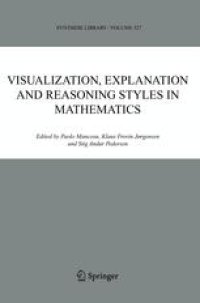
Ebook: Visualization, Explanation and Reasoning Styles in Mathematics
- Tags: Mathematics general, Visualization, History of Mathematics, Mathematical Logic and Foundations, Philosophy of Science
- Series: Synthese Library 327
- Year: 2005
- Publisher: Springer Netherlands
- Edition: 1
- Language: English
- pdf
This book contains groundbreaking contributions to the philosophical analysis of mathematical practice. Several philosophers of mathematics have recently called for an approach to philosophy of mathematics that pays more attention to mathematical practice. Questions concerning concept-formation, understanding, heuristics, changes in style of reasoning, the role of analogies and diagrams etc. have become the subject of intense interest. The historians and philosophers in this book agree that there is more to understanding mathematics than a study of its logical structure. How are mathematical objects and concepts generated? How does the process tie up with justification? What role do visual images and diagrams play in mathematical activity? What are the different epistemic virtues (explanatoriness, understanding, visualizability, etc.) which are pursued and cherished by mathematicians in their work? The reader will find here systematic philosophical analyses as well as a wealth of philosophically informed case studies ranging from Babylonian, Greek, and Chinese mathematics to nineteenth century real and complex analysis.
This book contains groundbreaking contributions to the philosophical analysis of mathematical practice. Several philosophers of mathematics have recently called for an approach to philosophy of mathematics that pays more attention to mathematical practice. Questions concerning concept-formation, understanding, heuristics, changes in style of reasoning, the role of analogies and diagrams etc. have become the subject of intense interest. The historians and philosophers in this book agree that there is more to understanding mathematics than a study of its logical structure. How are mathematical objects and concepts generated? How does the process tie up with justification? What role do visual images and diagrams play in mathematical activity? What are the different epistemic virtues (explanatoriness, understanding, visualizability, etc.) which are pursued and cherished by mathematicians in their work? The reader will find here systematic philosophical analyses as well as a wealth of philosophically informed case studies ranging from Babylonian, Greek, and Chinese mathematics to nineteenth century real and complex analysis.
This book contains groundbreaking contributions to the philosophical analysis of mathematical practice. Several philosophers of mathematics have recently called for an approach to philosophy of mathematics that pays more attention to mathematical practice. Questions concerning concept-formation, understanding, heuristics, changes in style of reasoning, the role of analogies and diagrams etc. have become the subject of intense interest. The historians and philosophers in this book agree that there is more to understanding mathematics than a study of its logical structure. How are mathematical objects and concepts generated? How does the process tie up with justification? What role do visual images and diagrams play in mathematical activity? What are the different epistemic virtues (explanatoriness, understanding, visualizability, etc.) which are pursued and cherished by mathematicians in their work? The reader will find here systematic philosophical analyses as well as a wealth of philosophically informed case studies ranging from Babylonian, Greek, and Chinese mathematics to nineteenth century real and complex analysis.
Content:
Front Matter....Pages i-x
Visualization in Logic and Mathematics....Pages 13-30
From Symmetry Perception to Basic Geometry....Pages 31-55
Naturalism, Pictures, and Platonic Intuitions....Pages 57-73
Mathematical Activity....Pages 75-87
Tertium Non Datur: On Reasoning Styles in Early Mathematics....Pages 91-121
The Interplay Between Proof and Algorithm in 3rd Century China: The Operation as Prescription of Computation and the Operation as Argumento....Pages 123-145
Proof Style and Understanding in Mathematics I: Visualization, Unification and Axiom Choice....Pages 147-214
The Varieties of Mathematical Explanation....Pages 215-250
The Aesthetics of Mathematics: A Study....Pages 251-293
Introduction....Pages 1-9
Back Matter....Pages 295-314
This book contains groundbreaking contributions to the philosophical analysis of mathematical practice. Several philosophers of mathematics have recently called for an approach to philosophy of mathematics that pays more attention to mathematical practice. Questions concerning concept-formation, understanding, heuristics, changes in style of reasoning, the role of analogies and diagrams etc. have become the subject of intense interest. The historians and philosophers in this book agree that there is more to understanding mathematics than a study of its logical structure. How are mathematical objects and concepts generated? How does the process tie up with justification? What role do visual images and diagrams play in mathematical activity? What are the different epistemic virtues (explanatoriness, understanding, visualizability, etc.) which are pursued and cherished by mathematicians in their work? The reader will find here systematic philosophical analyses as well as a wealth of philosophically informed case studies ranging from Babylonian, Greek, and Chinese mathematics to nineteenth century real and complex analysis.
Content:
Front Matter....Pages i-x
Visualization in Logic and Mathematics....Pages 13-30
From Symmetry Perception to Basic Geometry....Pages 31-55
Naturalism, Pictures, and Platonic Intuitions....Pages 57-73
Mathematical Activity....Pages 75-87
Tertium Non Datur: On Reasoning Styles in Early Mathematics....Pages 91-121
The Interplay Between Proof and Algorithm in 3rd Century China: The Operation as Prescription of Computation and the Operation as Argumento....Pages 123-145
Proof Style and Understanding in Mathematics I: Visualization, Unification and Axiom Choice....Pages 147-214
The Varieties of Mathematical Explanation....Pages 215-250
The Aesthetics of Mathematics: A Study....Pages 251-293
Introduction....Pages 1-9
Back Matter....Pages 295-314
....